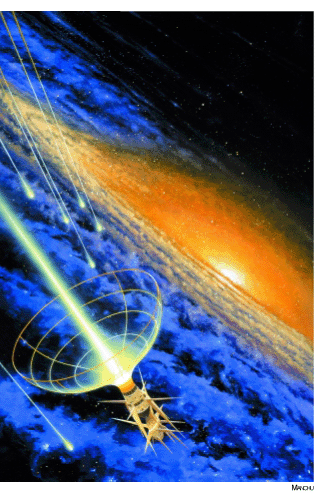 | To examine plot, let's look at Robert J. Sawyer's 2009 novel Wake. As faithful Electric Spec readers and writers know, Sawyer was kind enough to let us interview him in 2008. As Sawyer himself told Electric Spec, "My next book is called Wake... The theme is ... the waking up of a global consciousness, with all of it happening step-by-step on-stage while the reader watches. It's been the hardest book I've ever written, but I really do think I've managed some cool stuff in it." |
I agree Wake does have some cool stuff in it, in fact, it has a lot of cool stuff in it. Wake has two major pov characters, Caitlin a blind sixteen-year-old living in Canada, and an emerging global consciousness. These two characters have their own plots which are strongly interconnected. There are also several subplots that support the overall theme.The emerging global consciousness' journey begins with "Just awareness--a vague, ethereal sense of being. Being...but not becoming..." (p1) The reader first meets Caitlin after her first day at a new school: "Caitlin had kept a brave face throughout dinner, telling her parents that everything was fine--just peachy--but, God, it had been a terrifying day, filled with other students jostling her in the busy corridors, teachers referring to things on blackboards, and doubtless everyone looking at her." (p 1) Very soon Caitlin receives a bombshell when a Japanese scientist tells her "...I do think there's a fair chance that the technique we have developed may be able to at least partially cure your blindness..." (p6) Wow! Talk about a dramatic plot development!
Sawyer does a particularly nice job of utilizing other books and websites while telling his story, such as The Origin of Consciousness in the Breakdown of the Bicameral Mind by Julian Jaynes, and Hellen Keller's autobiography The Story of My Life: "Before my teacher came to me, I did not know that I am. I lived in a world that was a no-world." (p27) These books and sites are relevant to the plot; they help the pov characters understand what's happening. For example, Caitlin writes a review of Jaynes' book which includes "...I think being self-aware emerges when you realize that there's someone other than you." (p139)
One of the subplots involves an epidemic in China, which leads the Chinese government to undertake drastic measures including isolating the Chinese internet from the rest of the world. This subplot has a direct effect on the emerging consciousness which experiences "Worse than terror, as larger and larger chunks are carved off." (p52) Then when Sinanthropus, a Chinese revolutionary of sorts, tries to "...keep this little portal open..." (p60), the emerging consciousness notices "What is that?...Straining to perceive it, to make it out, this unusual...sensation, this strange...voice!" (p60) Suffice to say, this episode helps the consciousness on his journey.
Another subplot which has a significant effect on the emerging consciousness is Hobo "...a very real, very alive adult male chimpanzee." (p89) Hobo has his own mental journey which starts when "Hobo let out a startled hoot. --as a small male orangutan made his way onto the chair visible on the screen..." (p92) "The first-ever interspecies webcam call was off to a great start." (p93) Hobo helps the emerging consciousness attain consciousness.
Of course, the hero is really Caitlin and the reader cheers when she has "...a sensation, a something, like bursting, or...Or flashing." (p83) "...these different...flavors of light, they were colors!" (p84) "...Caitlin is seeing the Web connection somehow?" (p98) The Japanese scientist Kuroda says, "...I was thinking we should call it 'websight.'" (p129) Caitlin is well on her way to attaining the ability to see the real world. Hurray!
During her journey, she discovers the emerging consciousness and they learn to communicate. In fact Caitlin takes on the role of its teacher because "Helen Keller had been uplifted by Annie Sullivan. And the...the whatever it was...surely could also be brought forth." (p287) Thus, the emerging consciousness thinks, "My teacher continued with the lesson, and I struggled to follow along..." (p278) And after a lot of help from its teacher, "My mind was inflating, my universe expanding." (p322)
In the end... I wouldn't want to spoil it for you. I highly recommend you read for yourself what happens in the end. I'll just say all the plot lines and subplots tie together very nicely. Kudos, Mr. Sawyer.





